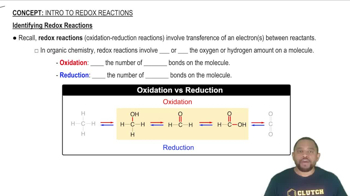Here are the essential concepts you must grasp in order to answer the question correctly.
Voltaic Cell
A voltaic cell, also known as a galvanic cell, is an electrochemical cell that converts chemical energy from spontaneous redox reactions into electrical energy. It consists of two electrodes: the anode, where oxidation occurs, and the cathode, where reduction takes place. The flow of electrons from the anode to the cathode through an external circuit generates electric current.
Recommended video:
Redox Reactions
Redox reactions involve the transfer of electrons between two species, resulting in changes in their oxidation states. In these reactions, oxidation refers to the loss of electrons, while reduction refers to the gain of electrons. Understanding the half-reactions for each component is crucial for identifying which species is oxidized and which is reduced in a given reaction.
Recommended video:
Identifying Redox Reactions
Electron Flow and Electrode Reactions
In a voltaic cell, electrons flow from the anode to the cathode through an external circuit. The half-reaction at the anode involves the oxidation of a species, while the half-reaction at the cathode involves the reduction of another species. Identifying the direction of electron flow and the specific half-reactions at each electrode is essential for accurately sketching the cell and understanding its operation.
Recommended video:

 Verified step by step guidance
Verified step by step guidance


